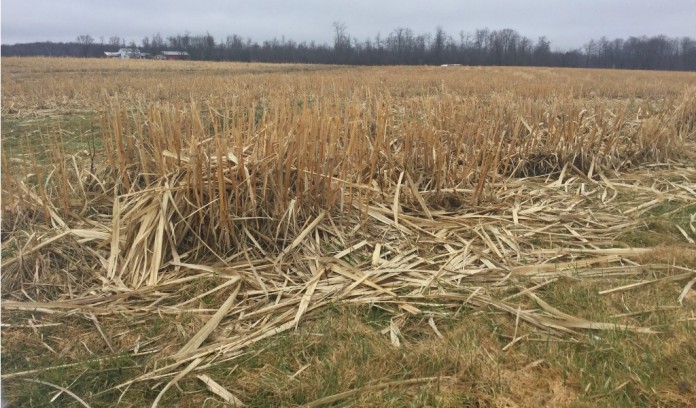
JEFFERSON, Ohio — In 2011, giant miscanthus was introduced to northeastern Ohio, and residents in the area became curious as to what this tall grass-like plant was. Is it invasive? Is it taking up cropland? What do you use it for? Ashtabula County Extension organized a tour March 11 for those curious about the plant and maybe considering growing it themselves.

What it is
The tour started at the county Extension office where David Marrison, county Extension director, gave an overview of the miscanthus crop. Giant miscanthus is a sterile, hybrid perennial warm-season grass that grows in marginal soils — a type of soil that is prevalent in Ashtabula County. Miscanthus was picked to grow in those abandoned areas of poor soil quality because cash crops would not grow well there.
It can grow up to 12 feet high and produce 10-15 tons per acre or more once it is established. Miscanthus is planted by rhizomes and typically is not harvested until the second year of production. The crop will continue to grow for up to 20 years. The tall, grass plant can be used as a biofuel or used to make bio-based products.
There are nearly 4,000 contracted acres of Miscanthus growing in northeast Ohio and northwest Pennsylvania, organized by the USDA’s Farm Service Agency and Aloterra Energy. Planting of miscanthus began in 2011, spurred by the USDA’s Biomass Crop Assistance Program (BCAP) to encourage the planting of renewable biomass crops.
Harvest

Due to heavy rainfall the day before the tour, harvest equipment was unable to get in the fields to provide a demonstration. In fact, the wintertime harvest of the crop often provides a challenge to miscanthus growers.
The crop must be harvested in the winter during its dormancy period, falling between a time of a hard-killing frost in the fall and before the emergence of the new shoots in the spring. This allows the plant to send nutrients down to the root system in the fall to spur next year’s plant growth.
A winter harvest poses its share of challenges; dealing with the cold, wet weather this time of year is famous for. Miscanthus was first harvested much like a traditional hay harvest — cut into windrows, raked and baled. The more time this highly absorbent plant spent sitting on the ground after harvest, the more moisture it soaked up. This led to a forage-based harvest approach of chopping miscanthus — much like harvesting haylage or corn silage. The target moisture content is 15 percent.
Equipment

Although they were not able to see a harvest in action, tourgoers were able to see the equipment used by Aloterra at the company farm. Choppers, wagons and some of the other equipment have been outfitted with tracks to help them navigate wetter field conditions during the harvest season. According to Aloterra Farm Manager Tom Spencer, miscanthus can be harvested at a rate of 2-5 acres per hour, depending on the field. Denser fields where the crop grows thick can slow equipment.
Miscanthus use
The original intent of miscanthus grown in northeast Ohio and northwest Pennsylvania was to be used as a biofuel product, but there isn’t enough acreage in the area, according to Jon Griswold, CEO of Aloterra. Instead, Aloterra chose a different route, creating natural absorbents and bio-based packaging products.

Aloterra developed two facilities for processing miscanthus. Its facility in Andover, Ohio, takes advantage of the plants’ natural absorbency by developing products to manage spills. Officials said miscanthus can absorb up to five times its weight, putting it in high demand among oil companies. Miscanthus can also be used as livestock bedding.
The tour concluded with a trip to the Ashtabula facility where miscanthus is processed into biodegradable packaging and paper products such as plates and clamshells for food service industries. Aloterra produces 50 million pieces from 3,000 tons of miscanthus a year.









